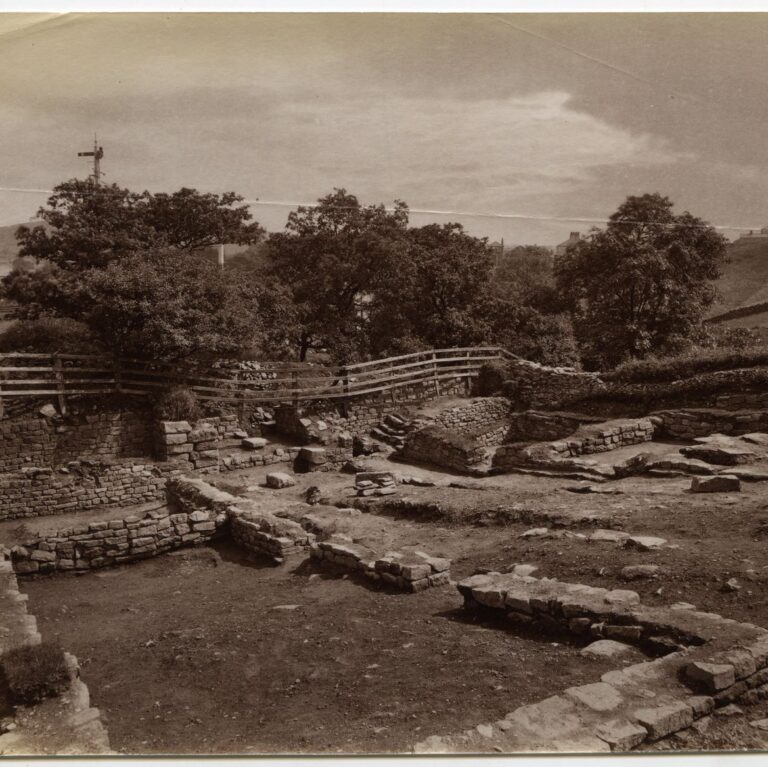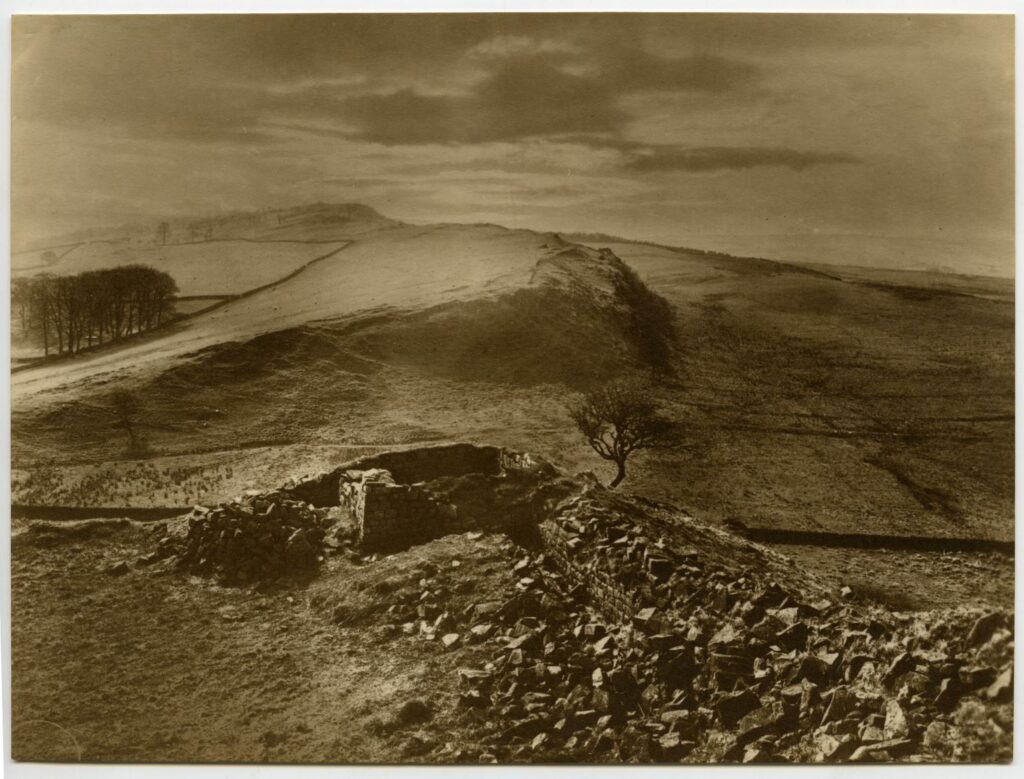Photographs of Milecastles and Turrets along Hadrian’s Wall, about 1892-1909
Reference: NRO 01876/C/7/38 & 49, NRO 08176/C/8/136
Suggested age groups: KS1, KS2, KS3, KS4, Lifelong Learners
Subject areas: History, Geography, Maths, Art & Design
CONTEXT
Milecastles are small forts which were built during the Roman period. They were placed at intervals of one Roman mile (1481 metres or 0.92 present day miles) along Hadrian’s Wall.
The size of Milecastles varied but they generally measured by about 15 metres by 18 metres, standing about 5 to 6 metres high, with stone walls as thick as 3 metres deep.
Milecastles guarded a gateway through the Wall and had a corresponding causeway across the Wall ditch to the north. They each had a garrison of soldiers in two barrack blocks.
Stone turrets were located about 500 metres either side of Milecastles. The garrison from the Milecastle likely also manned the turrets.
There were 80 Milecastles and 158 turrets along Hadrian’s Wall.
NRO 01876/C/7/38 – Milecastle 39 is located at Castle Nick, northeast of Once Brewed. It was excavated in 1854 by John Clayton. This photograph was taken in about 1905.
NRO 01876/C/8/136 – Milecastle 48 was excavated by J.P. Gibson and F.G. Simpson in 1909. This photograph was taken in about 1909.
It is located in Poltross Burn, Gilsland, just over two miles from Birdoswald Fort. It is one of the most significant Milecastles on the Wall both because of its preservation and the information its excavation has provided.
NRO 01876/C/7/49 – Turret 44b is located at Mucklebank, near Walltown Crags. This photograph was taken in about 1892.
These photographs were taken by John Pattison Gibson (1838-1912), a photographer and archaeologist from Hexham.
Gibson had a particular interest in Hadrian’s Wall, took part in several excavations, and used his photographs to document the findings between about 1890 and 1910. The photographs provide a unique record of the Wall and surrounding countryside at this time.
His first significant archaeological discovery was the Mucklebank Wall turret in 1891 which he happened upon thanks to a rabbit hole. He was involved in the excavation of the turret in 1892 and later he assisted in the excavations at Great Chesters from 1894-1896.
Between 1907-1908 he worked with Frank Gerald Simpson in excavating the small fort at Haltwhistle Burn and then once again in 1909, together with F.G. Simpson, he excavated Milecastle 48. The excavation report was published the following year and is one of the most important excavation reports published on a site on Hadrian’s Wall.
The Gibson Collection is housed at Northumberland Archives. Images from the collection can be viewed in the virtual exhibition Photographing the Roman Wall, then and now created in collaboration between Northumberland Archives and Northumberland Libraries as part of the Hadrian’s Wall 1900 Festival – a celebration of the 1900th anniversary of the Wall.
ROMAN READING LIST
The following books are available at Northumberland Libraries. Click to browse the online catalogue here.
Britain through the ages: Roman Britain by Felicity Hebditch (2003). ISBN: 0237526360.
You are in Roman Britain by Ivan Minnis (2005). ISBN: 1844432920.
The Roman soldier’s handbook by Lesley Sims (2014). ISBN: 9781409567745.
Roman Fort by Mick Manning (2004). ISBN: 184507050X.
Clues to the past: Everyday life in Roman times by M.J. Corbishley (2003). ISBN: 0749620315
ACTIVITIES
ACTIVITY 1
Background
Milecastles are small forts which were built during the Roman period. They were placed at intervals of one Roman mile (1481 metres or 0.92 present day miles) along Hadrian’s Wall.
SEE
See: What is a Milecastle?
See: Where are Milecastles found?
See: How far apart are Milecastles?
See: How big are Milecastles?
See: How many Milecastles were there along Hadrian’s Wall?
See: How many turrets were there along Hadrian’s Wall?
See: How long is a Roman mile?
THINK
Think: Why are there so many Milecastles and turrets?
Think: Why were Milecastles built one Roman mile apart from each other?
Think: Why are Roman miles a different distance to present-day miles?
Think: What would it have been like to be inside a Milecastle?
Think: Why were the walls of Milecastles and turrets so thick?
DO
Do: Look at the photographs. What evidence can you see of Milecastles and turrets?
Do: Write down the words that you would use to describe the Milecastles and turret in the photographs.
Do: Look at the photographs. Draw what you think the Milecastle might have looked like.
Do: Make your own Milecastle or turret out of recycled material.
Do: Design a Milecastle in Minecraft.
Do: If there were 80 Milecastles along Hadrian’s Wall, can you work out how many Roman miles were covered by Milecastles?
Do: If there were 80 Milecastles along Hadrian’s Wall, can you work out how many present-day miles were covered by Milecastles?
Resources
OTHER ONLINE RESOURCES
Roman Britain page about Milecastle 39: https://www.roman-britain.co.uk/places/hadrians-wall-milecastle-39-castle-nick/
Visit Cumbria page about Milecastle 48: https://www.visitcumbria.com/car/milecastle-48/
English Heritage page about Milecastle 48: https://www.english-heritage.org.uk/visit/places/poltross-burn-milecastle-hadrians-wall/
Roman Britain page about Milecastle 48: https://www.roman-britain.co.uk/places/hadrians-wall-milecastle-48-poltross-burn/
Tynedale Hadrian’s Wall Group page about milecastles and turrets: https://www.u3ahadrianswall.co.uk/wordpress/milecastles-turrets-and-walls/
English Heritage page about the excavation of Hadrian’s Wall: https://www.english-heritage.org.uk/visit/places/hadrians-wall/hadrians-wall-history-and-stories/history/research/




